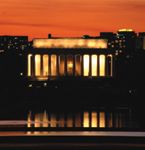Treasures: A nation honors its past
It was established on cheap swampland that was once thought uninhabitable, but it became the capital of "the last best hope of man." Its wide avenues, streets, monuments, and buildings play witness to the steady march of time and history.

It was burned by the British in 1814, but rose from the ashes. It greeted Lincoln as he stepped off the train from his hometown of Springfield. And sent him back home after that fateful Good Friday at Ford’s Theater, when he was shot.
It's where Roosevelt sat by a fire and told a severely depressed America, "The only thing we have to fear is fear itself."
If you're any kind of history buff, this is your chance to see and perhaps relive the events that shaped this nation. And the best part of it is, most of the historical attractions are free.
Washington, DC, is America's first fully designed city. The State of Maryland ceded the land to the federal government, and a plan for the city was laid out in 1791 by a Frenchman, Pierre L'Enfant, who was assisted by Benjamin Banneker, an African-American scientist.
The site was chosen as a compromise between a location in the industrial North and the rural, slave-holding South. It lies about halfway between the two. It was also accessible to the sea by the Potomac River.
One of the most recognizable features of the Washington, DC, skyline is the Capitol Dome. The original Capitol Building was designed by Dr. William Thornton, an amateur architect, who submitted a plan as a part of a contest held in 1791. He won $500 and a city lot for his design-quite a tidy sum for the day.
During its existence, the Capitol has been redesigned and rebuilt several times. The present Senate and House Wings and the distinctive iron dome were designed and constructed by Thomas U. Walter, the fourth architect to work on the Capitol, between 1851 and 1863. Indeed, much of the construction of the dome occurred during the Civil War.
Farther up the Mall (which also has a rich history) and south of the White House, sits the Washington Monument. Dedicated to George Washington, work started on the monument in 1848, but was later halted due to squabbling among various contractors. The Civil War disrupted construction so much that the project was almost abandoned until 1876, but the U.S. government stepped in and took over. At that time, the structure was only 150 feet tall. When construction resumed, the marble used was taken from a different quarry. Indeed, it is said you can still see the transition line where work resumed in 1876. Dedicated in 1885, this shimmering obelisk of white marble stands more than 555 feet tall, making it the tallest all-masonry structure in the world.
One of the more sublime historical attractions is the Lincoln Memorial. Dedicated on May 30, 1922, the memorial sits at the end of the Mall facing the Washington Monument and the Capitol in West Potomac Park. This large marble hall encloses a heroic statue of Lincoln, sitting in meditation on a large armchair. It is truly awe-inspiring.
The statue was designed by Daniel Chester French and sculpted by both French and the Piccirilli brothers. Murals and ornamentation are by Jules Guerin.
In the south chamber, you'll find a text of the Gettysburg address engraved in stone, while the north chamber features the text of Lincoln's second inaugural-Lincoln's two greatest speeches.
A visit to Washington just isn't complete without taking some time to honor those who "gave their last full measure of devotion," that we would remain free. Arlington National Cemetery is an essential stop.
Here you'll find row after row of identical white headstones, a tribute to brave men and women who fought for their country. Formerly the estate of Confederate leader Robert E. Lee, Arlington was established during the Civil War by then-Secretary of War Edward Stanton. It was said that Stanton wanted to place the honored dead right on Lee's front door step. Needless to say, it quickly became hallowed ground. Lee never returned after the war.
Nearly 200,000 U.S. military men and women are buried here from every major war. Arlington is the home of the Tomb of the Unknowns as well as the graves of John F. Kennedy, his wife, Jacqueline Bouvier Kennedy Onassis, and his brother, Robert.